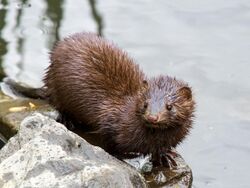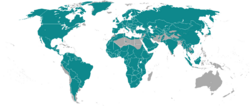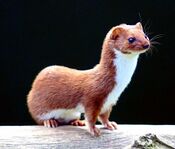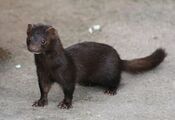Biology:Mustelinae
| Mustelinae | |
|---|---|

| |
| American mink | |
| Scientific classification | |
| Domain: | Eukaryota |
| Kingdom: | Animalia |
| Phylum: | Chordata |
| Class: | Mammalia |
| Order: | Carnivora |
| Family: | Mustelidae |
| Subfamily: | Mustelinae G. Fischer de Waldheim, 1817 |
| Genera | |

| |
| Mustelinae range | |
Mustelinae is a subfamily of family Mustelidae, which includes weasels, ferrets, and minks.[1][2]
It was formerly defined in a paraphyletic manner to also include wolverines, martens, and many other mustelids, to the exclusion of the otters (Lutrinae).[3]
Extant species of Mustelinae
Subfamily Mustelinae
| Image | Genus | Living species |
|---|---|---|
 |
Mustela Linnaeus, 1758 (weasels, ferrets, European mink and stoats) |
|
 |
Neogale Gray, 1865 (New World weasels and mink) |
|
The sea mink (Neogale macrodon) is a recently extinct species from the 19th century that was native to the Maritime Provinces of Canada and New England in the United States .
Importance for humans
Some of the fashion furs come from this subfamily: ermine, weasel, mink and polecat.[4]
Ferret model of COVID-19
COVID-19 can infect both the European mink (Mustela lutreola) and the American mink (Neogale vison). Ferrets are used to study COVID-19.[5] Ferrets get some of the same symptoms as humans,[6] but they get less sick than farmed mink.[7] Ferrets are a fairly uncommon animal to use as a model, but mice were not an easy model of COVID-19 because mice lack the ACE2 gene.[5]
References
- ↑ Nascimento, F. O. do (2014). "On the correct name for some subfamilies of Mustelidae (Mammalia, Carnivora)". Papéis Avulsos de Zoologia 54 (21): 307–313. doi:10.1590/0031-1049.2014.54.21.
- ↑ Law, C. J.; Slater, G. J.; Mehta, R. S. (2018-01-01). "Lineage Diversity and Size Disparity in Musteloidea: Testing Patterns of Adaptive Radiation Using Molecular and Fossil-Based Methods". Systematic Biology 67 (1): 127–144. doi:10.1093/sysbio/syx047. PMID 28472434.
- ↑ Koepfli KP; Deere KA; Slater GJ et al. (2008). "Multigene phylogeny of the Mustelidae: Resolving relationships, tempo and biogeographic history of a mammalian adaptive radiation". BMC Biol. 6: 4–5. doi:10.1186/1741-7007-6-10. PMID 18275614.
- ↑ "History of Fur in Fashion: Introduction". 4 December 2011. http://www.fashionintime.org/history-fur-fashion-introduction/.
- ↑ Jump up to: 5.0 5.1 Muñoz-Fontela, César; Dowling, William E.; Funnell, Simon G. P.; Gsell, Pierre-S.; Riveros-Balta, A. Ximena; Albrecht, Randy A.; Andersen, Hanne; Baric, Ralph S. et al. (October 2020). "Animal models for COVID-19" (in en). Nature 586 (7830): 509–515. doi:10.1038/s41586-020-2787-6. ISSN 1476-4687. PMID 32967005.
- ↑ "Table 1 SARS-CoV-2 infection in humans and in animal models" (in en). https://www.nature.com/articles/s41586-020-2787-6/tables/1.
- ↑ Racaniello, Vincent; Despommier, Dickson; Dove, Alan; Condit, Rich; Barker, Brianne; Griffin, Daniel; Rosenfeld, Amy. "TWiV 679: Mink, mutation, and myocytes | This Week in Virology". https://www.microbe.tv/twiv/twiv-679/.
External links
Wikidata ☰ Q27888 entry
 |


